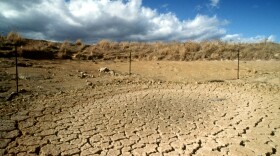From Texas Standard.
More than 40 percent of Texas is in some stage of drought right now, according to the latest data from the U.S. Drought Monitor. Some parts of the state are especially dry, like the Panhandle and the plains south of the area. That has caused some farmers and ranchers to face difficult choices – like what to do with cattle when there’s not enough grass to graze.
Quentin Gass is the ranch manager of Driver Land and Cattle in Glasscock County, about thirty miles east of Midland. He manages over 100,000 acres of land and about 2,000 cows.
“We’re just fortunate enough we’re scattered across five counties,” he says. “Our further western part’s last good rain was in September 2017. Since then, we’ve had one inch of rain.”
Gass says the current drought is going to be more severe than the drought in 2010, and his ranch never fully recuperated from what happened eight years ago.
“We have two different ranches that have been drafted out this year,” Gass says. “Fortunately, one ranch was able to move to other ranches to relocate the cattle. But the furthest ranch to the west – we don’t have the room for the rest of the cows. So we’re going to liquidate over 90 percent of them, I had 100 on 13,000 acres which is 130 acres per cow, and I’m gonna end up with about 15 cows on 13,000 acres and try to keep them alive.”
He says the majority of the cows will probably be slaughtered.
“There’s just not a big demand for cows right now,” he says, “Everybody was in a drought until this last week.”
Drought isn’t the only factor affecting Gass’ ranch. He says pests are also having a negative effect.
“The rabbit population after the drought of 2010 – when the drought broke, everything started coming back,” he says.. “The rabbit population just multiplied. They did a rabbit hunt out there for 24 hours, and there were over three teams that brought in over 1000 rabbits each in 24 hours.”
The rabbits eat the grass that is supposed to be eaten by the cows, which is more competition for the cattle, Gass says. He can’t put cattle on the land because there are too many rabbits eating the grass and keeping it too short.
“It’s a challenge. But it’s a challenge that we have learned to adapt with. We just take it as we can. Just take the good with the bad,” he says, “It ain’t for the weak-hearted. I can tell you that.”
Written by Amber Chavez.





